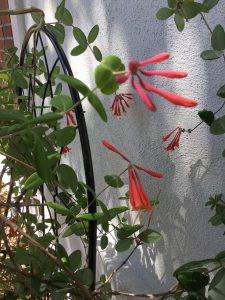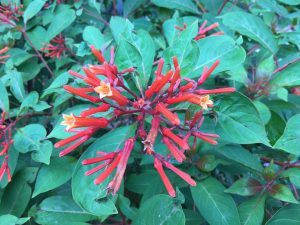There is nothing more exciting than seeing or hearing that cute little ruby-throated hummingbird in your own garden. Often they are heard before seen and then quickly flutter away. You too can enjoy the excitement of providing a habitat for hummingbirds in your own landscape. The key to attracting hummingbirds is to know which hummingbirds live in our area, when they are active, and what plants and habitat will make them feel welcome and sustain their needs.
Hummingbirds of Florida
First, here in Florida, we have three different species that visit the state. The rufous and black-chinned hummingbirds might stop by during the winter. Otherwise, you’re more likely to spot the ruby-throated hummingbird. The ruby-throated hummingbird is most obvious with a red, iridescent color on the neck. These eye-catching hummingbirds with red throats can be seen beginning in March and stick around until September or slightly later. Now you can easily figure out, based on the time of year, which hummingbird has visited your garden.
Plants for Hummingbirds

Next, in order to sustain hummingbirds near your garden, you will need to provide an ongoing nectar source. The easiest way to do this is by planting a variety of flowering plants that will provide nectar from March through September. Choose flowers that are red, orange, or even pink and tubular shaped. Some options for plants that will attract hummingbirds include native and Florida-Friendly plants like vining coral honeysuckle (Lonicera sempervirens), shrubby firebush (Hamelia patens), and reseeding scarlet sage (Salvia coccinea). For more on plants for attracting hummingbirds check out http://edis.ifas.ufl.edu/topic_hummingbird_plants.
You may also be considering the addition of a hummingbird feeder to the garden. While hummingbird feeders can help, it is better to provide as many flowers for hummingbirds as a natural source of food. Be sure to mix the sugar solution correctly and change every three to five days to avoid solutions becoming harmful and not safe for hummingbirds to consume. To read more about hummingbird feeders check out http://gardeningsolutions.ifas.ufl.edu/design/gardening-with-wildlife/hummingbird-feeders.html.
Maintain a Florida-Friendly Landscape

Finally, make sure you maintain your landscape in a Florida-Friendly way. This includes choosing the right plant for the right place, providing plenty of flowering plants with nectar as a food source throughout the seasons, and managing yard pests responsibly. To learn more about Florida-Friendly Landscaping visit http://sfyl.ifas.ufl.edu/polk/gardening-and-landscaping/florida-friendly-landscaping/.
Enjoy your time in the garden and landscape and hopefully you will be lucky enough to see or hear a hummingbird buzzing around!
For more information on hummingbirds check out:
• Hummingbird Gardens
• Hummingbirds of Florida
• How to Make Your Garden Hummingbird Friendly
• Hummingbird Feeders
Reference
Schaefer, Joe, Huegel, Craig N. (2017). Hummingbirds of Florida. IFAS Publication Number WEC21. Gainesville: University of Florida Institute of Food and Agricultural Sciences. Retrieved from https://edis.ifas.ufl.edu/pdffiles/UW/UW05900.pdf
 0
0
